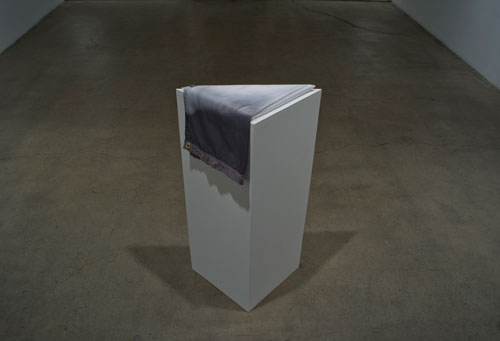“White Riot…be the beacon, be the light. KO’d by love” seduces with its elegance then simultaneously puts one off and seduces a second time with its literary and other cultural presumptions. Not pretensions: we can see that Capistran is intimate with these literary (and pop culture) references. (LA viewers may recall the break dance he performed on a Carl Andre in the 2008 LACMA “Phantom Sightings” show.) Capistran has had similar engagements with, among other divergent facets of the cultural mainstream, Richard Serra, Frank Stella, Led Zeppelin, Black Flag and Sister Sledge.
The show’s title is an almost infuriating mash-up of references. In a gallery become seemingly a chamber of visual white noise, we get that it’s coming from a place both beyond comprehensive grasp and radiant, with an illumination borne out of something very dark. The show consists of five photographs of objects chosen with deliberately political intent. Two are ambiguously cubical objects presented in flat, foreshortened orthogonals in a white field; another (flatter still), a placard in a slightly half-tone gray-white field; another a ghostly Molotov cocktail, a broken semi-lunar ellipse describing its base, with its faintly articulated body eliding into the white background; another, necessarily the most clearly articulated among the group, a clenched fist that might be a power salute, also “whited out.” On closer inspection, one of the cubical objects turns out to be a brick; the other, a pamphlet or booklet, which as it turns out is none other than Mao’s famous “Red Book”—painted white.
Capistran’s focus here, both formally and philosophically, is the liminal domain between conscious apprehension and comprehension or intention; the intersection—suggested by the Hawthorne passage from which he takes his titles—of memory, anticipation, desire, active consideration. The objects simultaneously emerge from and sink or fade into an abyss. But the work clings to its apprehensiveness in every sense. Capistran seems intent on focusing the viewer’s eye/mind on both confrontation and evasion. The whitewash fades into ink-stained, even blood-stained actualities, as on one of two prism-shaped columnar objects displaying a cloth “object,” folded like a flag and wearing a button “Till the razor cuts.” The white pedestal that lifts its white cloth banner is the central pivot of the show, none other than a black anarchist flag that has been bleached.
But Capistran seems to be reaching for something even larger—hence the self-consciously literary titles. Into the “intermediate” liminal space of Hawthorne’s “The Haunted Mind” comes “a funeral train” laden with the freight of Capistran’s parenthetical subtitles: “Passion and Feeling” (the brick); “Sorrow” (the bottle); “Hope turned to Disappointment” (the protest sign). The ‘power salute’ (“Shame”) comes closest to an actual response to the text: a waking conscience firmly asserting the fiction of innocence.
Can there be a romantic undercurrent to this austerity? You have to wonder with a title for the cloth and pedestal like “…when darkness has swallowed the reality…there is a light that never goes out…” The second half is not Hawthorne; and although I’m not going to say what I think it is, there’s something darkly romantic in it; and I think we all know that song.


